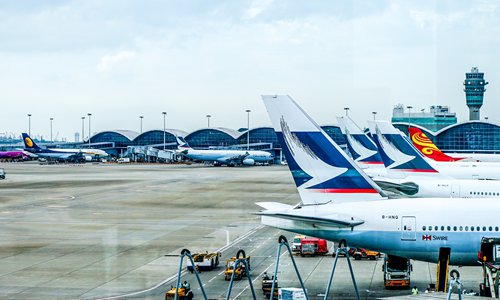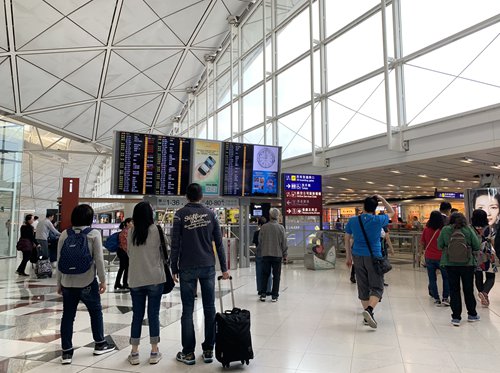HOME >> BUSINESS
Rise in capacity, decline in popularity for HK airport
Source:Global Times Published: 2019/8/8 18:23:40
Major transit hub faces fierce competition from neighboring cities

Aircraft at the Hong Kong International Airport File photo: IC

Passengers awaiting flights at the Hong Kong International Airport File photo: IC
Hong Kong International Airport (HKIA) has long been regarded as one of the top airports in the world in terms of services. However, as the riots in Hong Kong expand, the airport has been silent regarding protesters, shocking the public.
Given its significant history and geographical location, the airport plays an important role in the world civil aviation system. However, with the development of the Chinese mainland and the challenge posed by neighboring airports, the Hong Kong airport's advantage is slowly vanishing.
According to its fiscal report for the year which ended in March, its revenue declined to HK$19.5 billion ($2.49 billion) from a previous HK$21.9 billion, a decline of 11.5 percent. Passenger flow experienced a slight growth of 2 percent to 75.1 million, and cargo turnover saw a small dip of 0.6 percent to 5.06 million tons.
It seems that the main operational index remains stable and the airport still has an overall good performance, bar the decline in revenue. However, compared with neighboring airports, how long can the premium status of HKIA last?
The Pearl River Delta has other airports, including two in Shenzhen and Guangzhou which each witnessed a turnover of 10 million passengers, and both have maintained a high development rate in recent years.
Data from Civil Aviation Administration of China showed that the passenger throughput growth rate at Shenzhen International Airport in 2018 was 8.2 percent, and 5.9 percent at Guangzhou Baiyun International Airport - both higher than the 2 percent growth rate at HKIA
Although the airport holds great historical stock, and it is still the top regional airport in the Pearl River Delta, its growth rate has shown a downward trend.
Based on current growth trends, Guangzhou Baiyun International Airport's passenger throughput will surpass HKIA's in four years, and Shenzhen International Airport will surpass it in eight years.
The growth rate of passenger throughput at HKIA has fallen sharply since 2016, while the two airports in Guangzhou and Shenzhen have maintained strong growth.
Of course, HKIA, as the world's number one airport for cargo and mail throughput, ranks first in terms of cargo capacity.
In 2018, the cargo and mail throughput at HKIA reached 5.12 million tons, compared with 1.89 million tons at Guangzhou Baiyun International Airport and 1.21 million tons at Shenzhen International Airport.
However, data from HKIA showed that the cargo throughput from January to June 2019 dropped sharply year-on-year, and that the largest decline occurred in February 2019, down 14.2 percent, followed by June 1986, down 8.6 percent.
If this trend continues, Hong Kong's airport cargo throughput will see a sharp decline in 2019, and given the current situation in Hong Kong and the trade war background, there is little hope of reversing this trend for the time being.
Hong Kong airport dilemma
Since the abandonment of Hong Kong Kai Tak airport in 1998 and the opening of HKIA at Chek Lap Kok, the new Hong Kong airport has been performing very well and its profitability and throughput are among the highest in the world.
However, for HKIA, there has always been a problem that cannot be avoided: there is not enough space. Hong Kong's terrain is dominated by mountains, while the construction of airports requires large flats, meaning that land would need to be reclaimed to continue construction or to build a new airport.
HKIA had two runways at the beginning of its construction. However, for an international, large-scale hub airport, two runways cannot meet the growing demand. In 2011, the airport was preparing to reclaim land to build its third runway, but this was strongly opposed by the people of Hong Kong. Protesters believed that the third runway would cost HK$200 billion, which would be wasteful and have a negative impact on the environment.
Such opponents believe that the current capacity of HKIA is sufficient for use until 2040. They also believe that as long as Airport Authority Hong Kong (AAHK) improves efficiency and makes full use of the existing two runways, it can meet the aviation demand by 2030 without spending huge sums of money constructing a new runway.
Data showed that the annual passenger throughput of the two-runway airport reached 74.67 million in 2018. Shanghai Pudong International Airport has a similar throughput of 74 million passengers, yet it has four runways and is currently building its fifth and sixth. HKIA's cargo throughput of 5.12 million tons is also much higher than Pudong's 3.76 million tons.
Opponents have accused AAHK of "not being efficient" and opposed the construction of the third runway. AAHK's operation has been highly efficient and to refute this will only make people laugh.
The slowdown in growth since 2016 has fully demonstrated that Hong Kong's airport resources are becoming increasingly tight, and there is an urgent need to expand its scale to remain competitive.
Despite numerous objections, HKIA's third runway was approved in 2016, five years after the initial proposal, with a construction budget of HK$141.5 billion. It is scheduled to be completed in 2024.
Compared with HKIA's efficient operation, the construction process is extremely inefficient. In contrast, Shenzhen International Airport's third runway was approved in April this year. It is estimated to cost 9.2 billion yuan ($1.31 billion), and is scheduled to be completed and put into use in 2023.
Unpromising future
When I looked through the HKIA's annual report, I found a very interesting piece of data: the passenger injury rate.
The number of passenger injuries at HKIA was significantly higher in 2014, the year of the "Occupy Movement" in Hong Kong. Now that the city's unrest has spread to airport terminals, I believe that the passenger injury rate at HKIA will increase significantly.
According to the airport's financial report, Chinese mainland visitors accounted for 20 percent of the total number of Hong Kong's visitors, and were the second-largest demographic of travelers. This figure includes both mainland visitors in transit and those whose final destination is Hong Kong. As Hong Kong has become increasingly unfriendly to mainland tourists in recent years, Hong Kong's competitiveness as a tourist destination will decline.
The development of airports in Guangzhou and Shenzhen also poses a strong threat to HKIA as a transit location.
At the same time, HKIA is suffering from the combination of its own growth and gradual loss of competitiveness. It is not difficult to imagine that mainland passenger flow will decrease, which will further affect the development of the Hong Kong airport.
The article is based on a commentary by www.guancha.cn